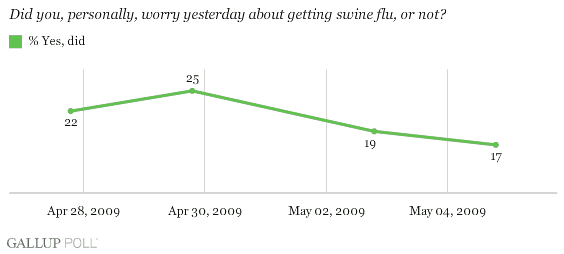WASHINGTON, D.C. -- Americans are as likely to say the media have exaggerated the dangers of swine flu (45%) as to say the news reports are about right (46%). Only 6% say the media are not taking the danger seriously enough.

The findings of this one-night USA Today/Gallup poll, conducted May 5, 2009, come as news coverage about swine flu has abated in the U.S. over the past several days. The U.S. Centers for Disease Control and Prevention have at this point confirmed 642 cases of and two deaths from H1N1 flu in the United States. Globally, there are more than 2,000 confirmed cases and 44 total confirmed deaths.
News coverage became widespread in the U.S. after Mexico on April 24 confirmed the first deaths related to the outbreak, and coverage escalated in the following days as the number of confirmed U.S. cases started to grow and the World Health Organization raised its pandemic alert level. The Project for Excellence in Journalism found that for the week ending May 3, swine flu accounted for almost a third (31%) of the news coverage across 55 news outlets studied.
Gallup tracked Americans' level of worry throughout that time and found that concern about getting swine flu peaked on April 30, when 25% said they were personally worried about getting it. Worry stands at 17% in the May 5 poll.

Regardless of their views of the news coverage, most Americans do not see swine flu as something that is likely to affect them or their families. Only 20% say it is very or somewhat likely that they or someone in their family will get swine flu while 79% say it is not too or not at all likely.

While to date, H1N1 has not had the widespread consequences some initially feared, the World Health Organization and other experts warn about the possibility that it will come back in a more virulent form when the next flu season begins. U.S. health officials said Wednesday they have identified many of the characteristics of the current strain and are well-positioned to manufacture a vaccine if the need arises. When asked if they would get such a vaccine if one were developed, 46% of Americans currently say yes, while 52% say no.
Survey Methods
Results are based on telephone interviews with 1,012 national adults, aged 18 and older, conducted May 5, 2009. For results based on the total sample of national adults, one can say with 95% confidence that the maximum margin of sampling error is ±3 percentage points.
For results based on a half sample, the maximum margins of sampling error are ±5 percentage points.
Interviews are conducted with respondents on land-line telephones (for respondents with a land-line telephone) and cellular phones (for respondents who are cell-phone only).
In addition to sampling error, question wording and practical difficulties in conducting surveys can introduce error or bias into the findings of public opinion polls.
Polls conducted entirely in one day, such as this one, are subject to additional error or bias not found in polls conducted over several days.
